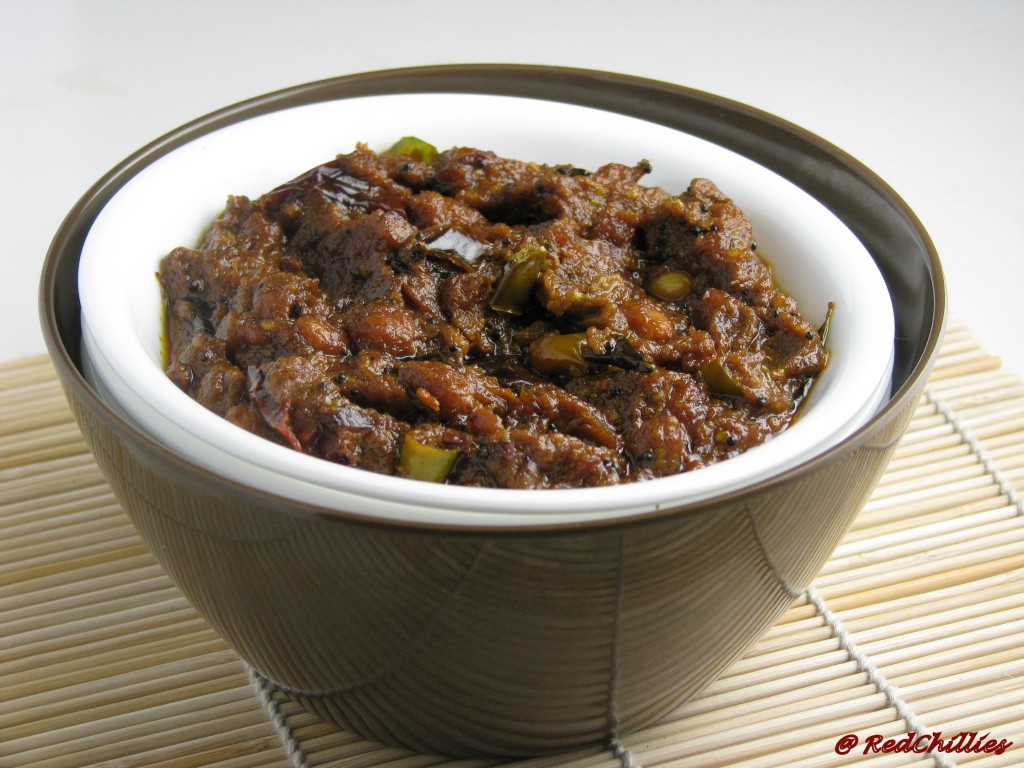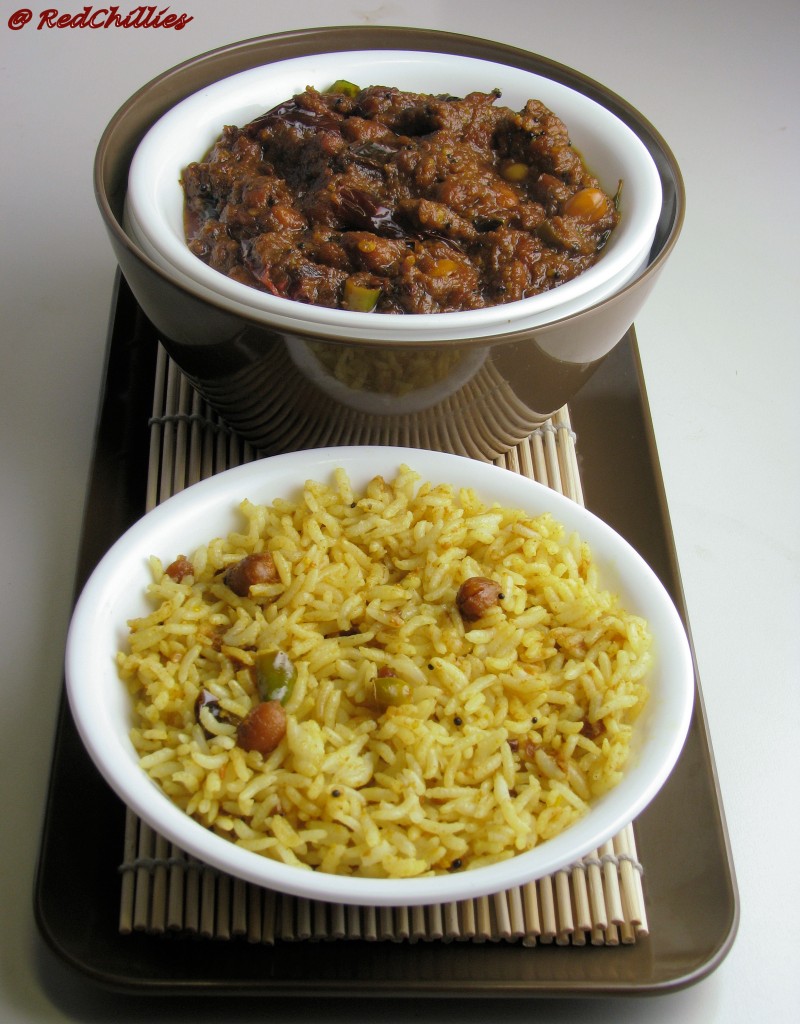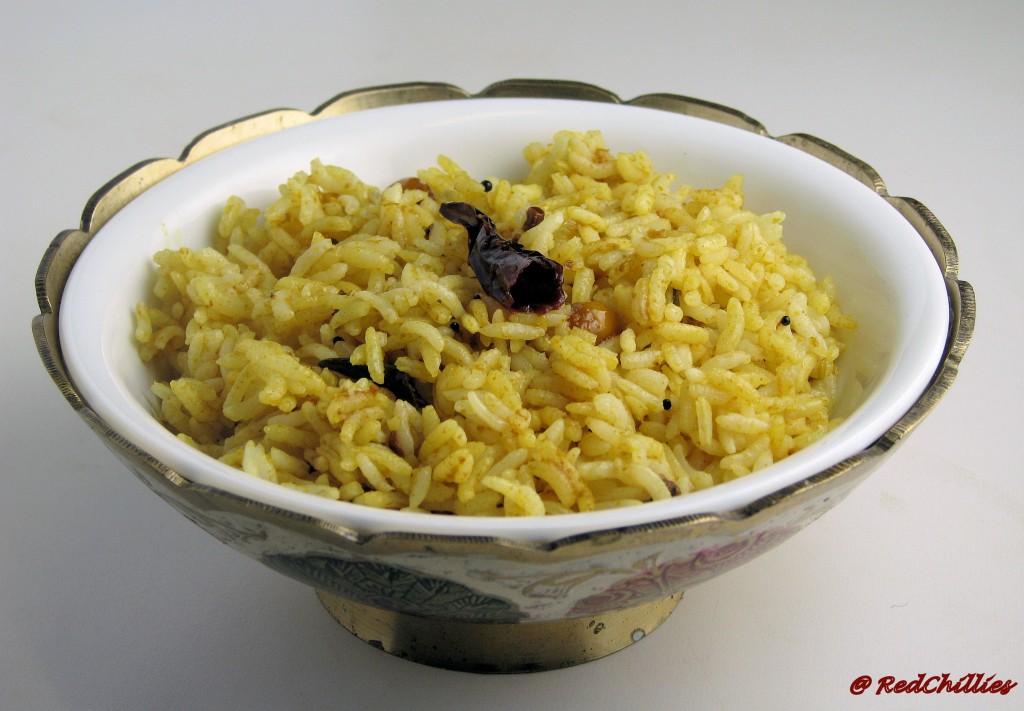
Puliyogare/Tamrind Rice is a South Indian rice preparation usually eaten as a snack/breakfast. Puli means sour taste and Ogara means rice in Halegannada (old Kannada), thus Puliyogare translates as sour tasting rice. (Source).
The rice is usually one of the items prepared during major festivals in South India and is offered as Prasadam in the temples. This is also referred to as Puliogare, Puliyodarai, Pulihora or simply tamarind rice. This rice has a sweet, tangy and spicy combination and the flavor is enhanced by the addition of crunchy peanuts. This rice does not involve addition of any vegetables similar to Lemon Rice.
There are different ways in which the rice can be prepared. Pulliyogare powder (MTR Puliogare Powder) or Gojju is prepared in advanced and then mixed with Rice. We prepared this Pulliyogare Gojju (Tamarind Masala Paste) inspired by the Vah chef. The Gojju can prepared in advance and stored in container for many days (like pickle). To prepare the rice, the required quantity is added to hot steaming rice, mixed thoroughly and then eaten. As simple as that and this is yummy and delicious food at its best.
The tamarind pulp is available in the Indian groceries. If a whole tamarind is available then soak about a handful of it in hot water and let it rest. After about 10 minutes, using hands mix and extract the pulp, and then strain impurities, fiber etc this way clean extract of tamarind pulp can be used. Since the Gojju/paste is made without using any water and boiled thoroughly, there is no need to refrigerate or freeze it. It can be kept in air tight for at least a month or longer depending on the quantity.

Ingredients: (For the gojju)
- 1 cup thick tamarind pulp
- ¾ cup peanuts
- 2-3 red chillies
- 2-3 green chillies cut into small pieces
- Mustard seeds
- Asafetida
- 1 Tbsp Sesame seeds
- Jaggery
- Salt
- 1 Tbsp Urad daal
- Curry leaves

Method:
- In a heavy bottom pan, heat oil (add more oil) on medium heat. Add mustard seeds until it splutters.
- Next add the curry leaves, asafetida/hing and mix for a while.
- Add red chillies, peanuts, urad daal and mix until the peanuts and urad daal becomes light brown.
- Add sesame seeds, green chillies and then the tamarind pulp. Mix well and allow to boil.
- After a while it begins to thicken. Add salt and little jaggery and continue to cook till it thickens. Keep aside.
- To make the rice, add required quantity to the rice and enjoy. Little gojju goes a long way.

The gojju is so dark yet the rice is a lovely yellow! I guess you need to add just a little of it. This is a great break from the usual lemon rice. Love it RC! 🙂
The bowls and the tray are a pretty choice! The gojju and rice looks simply delicious.
I adore tamarind rice! Once when I ran out of peanuts, I added peanut butter to the mix…it was hearty and delicious. I like this pre-made gojju idea.
my mouthwatered just looking at the gojju.. very delicious looking. I love puliyougre anytime..
Looks delicious, RC!
Ooh! Yum yum, Supriya. The poliyogare looks deliciously tangy!! I am going drool-drool:)
This was a big time favorite of ours when in college. My fiend’s mom used to make bottle fulls of this and we had it handy when the hostel food got intolerable which was pretty much everybody.
Looks delicious RC.
I am always amazed at how you manage to make the not-so-good-looking-food look like it is from the pages of a cookbook. Lovely pictures and lovely composition with bowls inside the bowls.
We too found the Wah chef a few days ago and love him, especially T who likes his enthusiasm and passion for food. 🙂
Not much to say about the rice, since had it maybe once but T likes it from his Madras days. Will see if he wants to make the tamarind paste and make the rice. 🙂
Yikes Jaya, you make me turn red and pink at the same time. Thanks for the warm comments though, I guess it is one of those days when things turn out fine.
Same here with the Vah chef, we watch his videos and DH gets inspired to cook, not that I am complaining 🙂
Gojju is looking very nice. I think u can add a tsp of chilli powder instead of green chillies so u get a little spicy taste too(just an option).This gojju I use when I have leftover rice, so the rice is used and its a fresh new dish.Nice click.
soumya thanks a bunch for the tip, I will keep that in mind the next time I try
Love this dish anytime, gorgeous clicks..
Looks Perfect!!!!
I love this rice…Very colorful..I make it in dark color…
Looks just perfect like the ones served in temple, have to try ur version sooner!
wow, homamade puliyogare gojju .. amazing
Wow! U just reminded me of one old neighbour she use to make similar kind…& I took recipe also from her but lost it….looks delicious & quite similar….bookmarked
Great…must make this…love puliogare, never bothered to make the gojju, since i got it in bangalore, but miss it a lot here, the powders just dont have the same effect…thanks for putting this up, am definately making this…
Quiet different ur recipe and the bowl is inviting to have some 🙂
I absolutely love Tamarind Rice. One of my neighbor makes it superb but she says she uses some pre-made masala
That paste makes me dip my finger in and lick;-) I love tamarind rice but never did the paste at home. Get the ready made paste;-( I could have a bowl of that delicious sour rice right.. yeah i had my lunch.
Hi,
My husband said he had this rice dish in one of his indian friends house. where can i buy the tamarind pulp? can this be made by putting the sweet whole tamrinds in the food processer.. I have seen them here in the korean markets.
One more question is how can i store this paste/ gojji? freeze it like vegetable stock?
Appreciate your help..
Thanks,
Lisa..
Thanks Lisa and appreciate your interest. The tamarind pulp is available in the Indian groceries. If you get whole tamarinds then soak about a hanfdul of it in hot water and let it rest. After about 10 minutes, using your hands extract the pulp, removing the impurities etc.
Since the Gojju/paste is made without using any water and boiled , there is no need to refrigerate or freeze it. It can be kept outside for atleast a month. Hope this helps.
Sounds very authentic,
lovely picture…
love anything tangy, this is the best.
This is a lovely recipe – simple but believe me it takes an expert hand to get the taste just right – not too sour, not too bland….you seem to have got it just right!!
I love puliyodarai and often take it to work, and end up using a ready mix in a hurry if I havent planned ahead. I’m going to make loads of this recipe and store it instead – thanks!
i just love this..but its been so long since ive had it…the picture looks great…
Hey Supriya, nice job on the recipes..hey, but as far as I know, we do not call puliyogare, huli anna. Bisibele bhaat is sometimes called huli anna. Didn’t mean to pick on you, I could be wrong but never heard it..
Thanks Geetha. I appreciate your input and I will modify the statement. I had used the source from Wiki for that, the link that I have provided.
My family calls puliyogare, Huli Anna. They are Hassan-Mysore-Chikmangalur Hoysala Kannadigas. So, I think you can leave it.
Hi, Like your gojju recipe. But did you forget to add what to do with the sesame seeds in the procedure? Do you dry grind it and add the powder or add it to the seasoning?
Thanks Chandra for pointing it out. I add it along with urad daal etc (no need to powder it). I have modified the post.